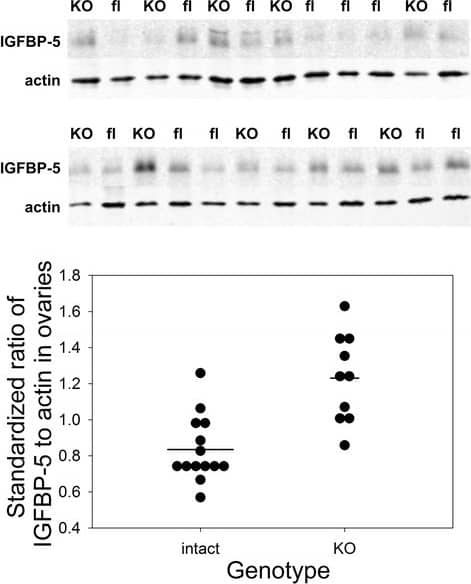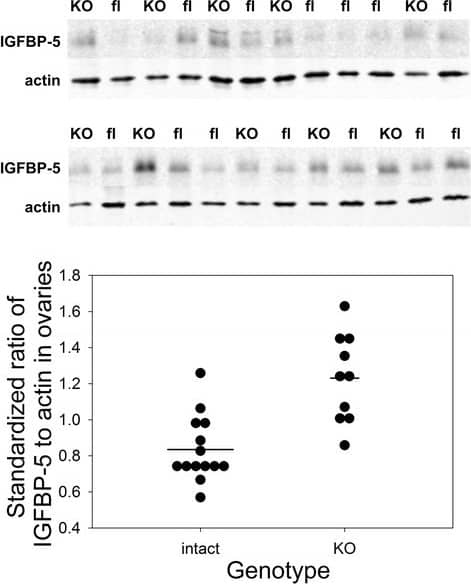Mouse IGFBP-5 Antibody
R&D Systems, part of Bio-Techne | Catalog # AF578


Key Product Details
Species Reactivity
Validated:
Cited:
Applications
Validated:
Cited:
Label
Antibody Source
Product Specifications
Immunogen
Val15-Glu271
Accession # Q3UQV0
Specificity
Clonality
Host
Isotype
Scientific Data Images for Mouse IGFBP-5 Antibody
IGFBP-5 in Mouse Ovary.
IGFBP-5 was detected in perfusion fixed frozen sections of mouse ovary (follicle with oocyte) using 5 µg/mL Goat Anti-Mouse IGFBP-5 Antigen Affinity-purified Polyclonal Antibody (Catalog # AF578) overnight at 4 °C. Tissue was stained with the Anti-Goat HRP-DAB Cell & Tissue Staining Kit (brown; Catalog # CTS008) and counterstained with hematoxylin (blue). View our protocol for Chromogenic IHC Staining of Frozen Tissue Sections.Detection of Mouse IGFBP-5 by Western Blot
Testicular IGFBP-5 levels, measured by Western blotting. Upper: Western blotting of IGFBP-5 and actin in the testes of males homozygous for the deletion allele (Pappa2KO/KO; KO) or the intact conditional allele (Pappa2fl/fl; fl). Lower: Ratio of the intensity of the IGFBP-5 band to that of the actin band, standardized by dividing an individual sample’s ratio by the mean ratio of all samples on the same blot. Horizontal lines represent the means for each group. Image collected and cropped by CiteAb from the following open publication (https://pubmed.ncbi.nlm.nih.gov/26416573), licensed under a CC-BY license. Not internally tested by R&D Systems.Detection of Mouse IGFBP-5 by Western Blot
Ovarian IGFBP-5 levels, measured by Western blotting. Upper: Western blotting of IGFBP-5 and actin in the ovaries of females homozygous for the deletion allele (Pappa2KO/KO; KO) or the intact conditional allele (Pappa2fl/fl; fl). Lower: Ratio of the intensity of the IGFBP-5 band to that of the actin band, standardized by dividing an individual sample’s ratio by the mean ratio of all samples on the same blot, such that the average value is 1. Horizontal lines represent the means for each group. Image collected and cropped by CiteAb from the following open publication (https://pubmed.ncbi.nlm.nih.gov/26416573), licensed under a CC-BY license. Not internally tested by R&D Systems.Applications for Mouse IGFBP-5 Antibody
Immunohistochemistry
Sample: Perfusion fixed frozen sections of mouse ovary (follicle with oocyte)
Western Blot
Sample: Recombinant Mouse IGFBP-5 (Catalog # 578-B5)
Mouse IGFBP-5 Sandwich Immunoassay
Formulation, Preparation, and Storage
Purification
Reconstitution
Formulation
Shipping
Stability & Storage
- 12 months from date of receipt, -20 to -70 °C as supplied.
- 1 month, 2 to 8 °C under sterile conditions after reconstitution.
- 6 months, -20 to -70 °C under sterile conditions after reconstitution.
Background: IGFBP-5
The superfamily of insulin-like growth factor (IGF) binding proteins include the six high-affinity IGF binding proteins (IGFBP) and at least four additional low-affinity binding proteins referred to as IGFBP related proteins (IGFBP-rP). All IGFBP superfamily members are cysteine-rich proteins with conserved cysteine residues, which are clustered in the amino- and carboxy-terminal thirds of the molecule. IGFBPs modulate the biological activities of IGF proteins. Some IGFBPs may also have intrinsic bioactivity that is independent of their ability to bind IGF proteins. Post-translational modifications of IGFBPs, including glycosylation, phosphorylation and proteolysis, have been shown to modify the affinities of the binding proteins to IGF.
Mouse IGFBP-5 cDNA encodes a 271 amino acid (aa) residue precursor protein with a putative 19 aa residue signal peptide that is processed to generate the 252 aa residue mature protein. Mouse, human and rat IGFBP-5 share 97% identity. IGFBP-5 is expressed by fibroblasts, myoblasts and osteoblasts, making it the predominant IGFBP found in bone extracts. IGFBP-5 has a strong affinity for hydroxyapatite, allowing it to bind to bone cells. When bound to extracelluar matrix, IGFBP-5 is protected from proteolysis and potentiates IGF activity, but when it is soluble, IGFBP-5 is cleaved to a biologically inactive 21 kDa fragment.
References
- James, P.L. et al. (1993) J. Biol. Chem. 268:22305.
- Jones, J.I. and D.R. Clemmons (1995) Endocrine Rev. 16:3.
- Kelley, K.M. et al. (1996) Int. J. Biochem. Cell Biol. 28:619.
Long Name
Alternate Names
Gene Symbol
UniProt
Additional IGFBP-5 Products
Product Documents for Mouse IGFBP-5 Antibody
Product Specific Notices for Mouse IGFBP-5 Antibody
For research use only


